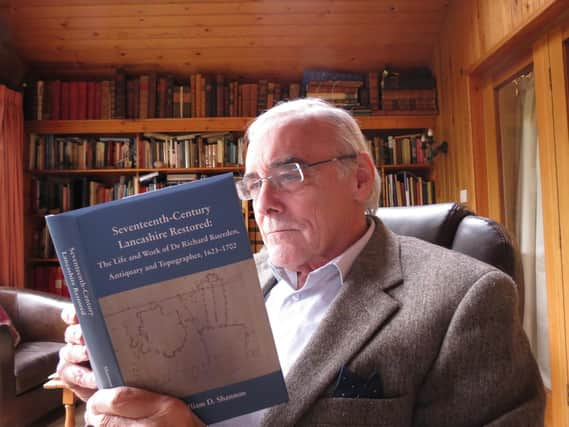Uncovering the fascinating works of Lancashire's first historian


In 1952, some old papers were found in the basement of Towneley Hall, Burnley, which turned out to be a survey of the roads of Lancashire, with street plans of Preston and Lancaster.
Now in the Lancashire Archives, they dated from the 1680s, and the consensus was that they were the work of an obscure local antiquary called Richard Kuerden.
Advertisement
Hide AdAdvertisement
Hide AdI had first learned of them in the 1980s, but thought no more about them until 2003, when I was doing an MA at Lancaster University, and used some of them for an assignment on Landscape Reconstruction.
Then, in 2014, I got involved with a group planning the commemoration of the 1715 battle of Preston, and I suggested the old plans would help with studying the progress of the battle.
In looking at them again, I found myself wanting to know more about the man who made them. Kuerden had written a brief autobiography, published in 1775 by the Manchester historian John Whitaker, which told us he was born in Cuerden, went to school in Leyland – in the building which now houses the South Ribble Museum – went to Oxford, became a Doctor of Medicine, and began practising in Preston in 1651.
He never married, and seems increasingly to have neglected his medical work, spending more and more time on what was intended to be a massive five-volume history of Lancashire, although it never got published.
Advertisement
Hide AdAdvertisement
Hide AdI later learned that he had died in poverty, and no-one knows where he is buried. What we do know is that he had left behind piles of hand-written documents. And so with the encouragement of David Hunt, curator of the South Ribble Museum, I decided to track them down.
Late in 2015 I visited the British Library to view their large book of Kuerden’s notes, more than 400 pages long. I suppose I was expecting a neat collection of transcriptions of deeds, charters and the like, the raw material of history.
What I saw was anything but neat. His handwriting was horrible. There was no order to the book, he had just written things down as they occurred to him, over many years. Large parts were not history at all, but things like medical notes and notes on heraldry. In among the historical material are numerous drafts for chapters for his great work, but most of them didn’t get very far.
However, there is a lengthy description of Leyland, Brindle and part of Chorley, full of fascinating detail, such as his account of the trees which were found underground while digging for peat on the Leyland mosses. Now known as Moss Stocks or Bog Oaks, Kuerden suggested ‘they have lyne over thrown … since Noahs flood’.
Advertisement
Hide AdAdvertisement
Hide AdIn mid-2016, I headed for Chetham’s Library in Manchester. Founded in 1653, the oldest public library in Britain, it holds two volumes of Kuerden’s work, another 1,200 pages, a great mish-mash of historical, medical, and general interest material, including a draft for a history of Preston.
I had, however, left the best until last. In September 2016, I visited the College of Arms, in the shadow of St Paul’s Cathedral, London, where there were a further eight volumes, together adding more than another 3.000 pages to my quest.
Most importantly they included examples of Kuerden’s map-making, a sketch map of the South Ribble area, and another of Pilling Moss. There were more medical and other notes: and interestingly, amid all the historical material, there were a few original documents Kuerden had borrowed and never returned, such as a list of Whalley Abbey’s possessions just after its
Dissolution, a list of all the gentry of Lancashire dating from 1576 – and a document of 1613 signed by a Herald, certifying the seal of the Borough of Preston.
Advertisement
Hide AdAdvertisement
Hide AdAnd so in 2017 I began writing up his biography. Far from the single-minded historian I had expected, I had found that he led an amazing intellectual life as a physician, antiquary, topographer, cartographer and perhaps even alchemist.
Despite his failure to get anything into print during his lifetime, he has left behind a huge legacy of material which amply justifies giving him the accolade of ‘Father of Lancashire History’.
* Bill Shannon is an Honorary Alderman of Preston Council and a Fellow of the Society of Antiquaries. Seventeenth-Century Lancashire Restored is available at reduced £25 inc P&P, until June 19, by contacting [email protected] and quoting the code LEPOFFER.